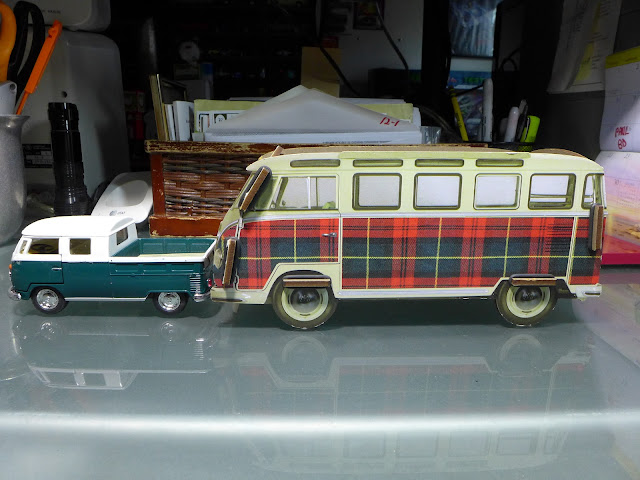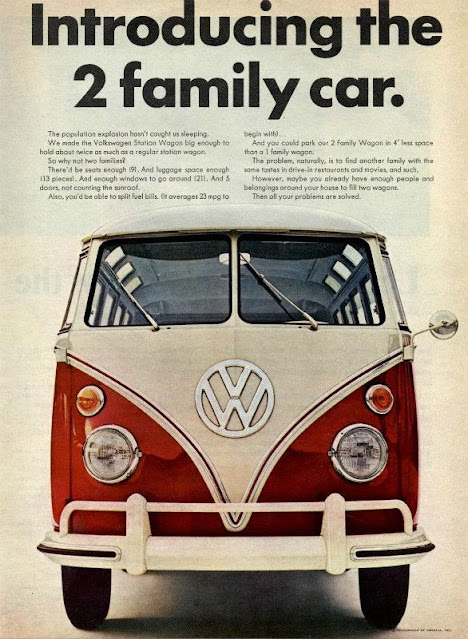June 16, 2023
#468
Gentle reader,
My previous article on 1/32nd scale Kinsmart diecast model cars dealt with my entire collection and the various brands being sold in stores in lieu of Kinsmart-made cars and trucks. At least in my part of the United States. Here is a link to that article: The Robb Collections: Highly Detailed 1:32nd Scale Diecast Model Cars for Six Dollars! Kinsmart Found A Niche and Filled It. And Volkswagen Buses!
These are the three VW busses I currently have in my collection in 1/32nd scale. I have numerous 1/64th scale VW diecast cars of many eras and countries of manufacturer of their real counterparts. I also have a 1/18th scale VW Bus seen "in situ" with it's fellow 1/18th scale cars below.
There are six of these cars which represent real ones I once owned. Starting at the forth shelf down: Black 1967 Chevrolet Impala SS. Mine was an off-white convertible with a more humble 300 horsepower 327 cubic inch small-block V8 engine compared to the "Rat Motor" 427 C.I. big-block in that hardtop model houses. I also had a 1974 Triumph Spitfire 1500. Red paint, black interior. That green one is a Mark IV with a smaller engine. The funny looking car to the right of the Spitfire is a 1970's Audi 100 Coupe. A model not sold in the US. I had a 1975 100LS four-door sedan, silver-blue in color. Fifth shelf down holds a JDM Subaru WRX STi wagon. I had the non-STi version. The STi models did not reach these shores for a few more years. Same color but not as powerful. The red Porsche 924 to the right is a 1985 model. I had a 1987 924S. Which was a completely different car beneath the shapely skin. Black in color. To it's right is a 2000 Audi TT. That model is a FWD model which was produced prior to Audi finding out that their TTs were unstable at Autobahn speeds. They added various aerodynamic aids including a rear spoiler. Mine was the same color with blue leather interior and an AWD quattro example. If you would like to learn what differentiates a Porsche 924S from the original 924, watch this video: The Porsche 924 wasn't born a Porsche. It became one. | Revelations with Jason Cammisa | Ep. 09 - YouTube
The golden car beneath the Subaru represents a 1964 Pontiac GTO convertible I test drove when I was seventeen and a senior in high school. It had the top 389 c.i. V8 engine with three two-barrel carburetors, four-speed manual transmission and positraction differential. The owner wanted $250 for it, which I did not have!
The VW bus represents one of the three my parents once owned, each newer than the previous. The color red is not what I have seen, but it works. In front of the Bus is a 1963 Ford Falcon, which was my wife's first car. Hers was a humble four-door sedan, light blue in color. It was two years older than she was! Lastly, the blue car to the right of the Falcon is a 2004 Australian-built Pontiac GTO. They were made for only three years. And, I WANT a real one.
These two period film photographs are what we are going to use to determine which of the three VW busses are the most accurate. My little sister and brother in the wooden VW bus the dealer gave to my parents when they bought the attached real Bus.
Same sister making a sassy pose beside Dad and one of the two early model VW busses we had. Can't tell, of course, whether it is the red one or the blue one. And, I just noticed those things beneath the side windows. What the heck are they, Bob?
Same sister making a sassy pose beside Dad and one of the two early model VW busses we had. Can't tell, of course, whether it is the red one or the blue one. And, I just noticed those things beneath the side windows. What the heck are they, Bob?
Let's start with the two Kinsmart models I have. The white over blue represents the two we grew up in riding around the western United States. One was white over red.
The white over green one is a double cab pickup truck. It states that it is a 1963 model. Made on February first, 2016. It is 1/34 scale. The bus is called 1962 Volkswagen Classical Bus. "Classical"? NOTE the difference in the windshield wipers placement. It was made in Qingyuan, China and has these number: 04221103. Funny looking date. I am convinced that the Bus model is very recently made. The entire stamp on the pickup reads: Kintoy Die-Casting Mfy., Ltd. Mfg in Shenzhen, China Mfg. on 02/01/2016 Batch #02001H96-22.
The bus is appears to be slightly taller than the pickup. Which makes sense since it is a slightly smaller scale. Read on for more on that specification.
I just measured the bodies with calipers width beneath the taillights. They are exactly the same width, at least at that point on the bodies.
The front doors on the pickup open, of which almost every Kinsmart model I have ever handled has had opening front doors. Yet, on the bus, they are molded shut.
The bus is appears to be slightly taller than the pickup. Which makes sense since it is a slightly smaller scale. Read on for more on that specification.
I just measured the bodies with calipers width beneath the taillights. They are exactly the same width, at least at that point on the bodies.
The front doors on the pickup open, of which almost every Kinsmart model I have ever handled has had opening front doors. Yet, on the bus, they are molded shut.
I measured the open passenger door on the pickup and it is 28mm at the paint demarcation line. The bus's door is about one millimeter wider there.
As I pointed out in the previous article, the Chinese designers probably are not aware that the engines should be at the BACK of the models, not at the front. Oops!
Now, I am not a Volkswagen expert, which is why I am counting on my buddy, Bob Berne, to tell me the differences between a 1962 and 1963, especially concerning FRONT lights.
I measured the pickup from the bottom and it is 133mm from the center of the front bumper to the center of the rear bumper. The bus is 132mm long at the same place. They are identical in height at 46mm. So, is one truly a different scale than the other?
As I pointed out in the previous article, the Chinese designers probably are not aware that the engines should be at the BACK of the models, not at the front. Oops!
Now, I am not a Volkswagen expert, which is why I am counting on my buddy, Bob Berne, to tell me the differences between a 1962 and 1963, especially concerning FRONT lights.
I measured the pickup from the bottom and it is 133mm from the center of the front bumper to the center of the rear bumper. The bus is 132mm long at the same place. They are identical in height at 46mm. So, is one truly a different scale than the other?
Now, let's look at two busses. Apples verses apples, so to speak. You've met the one on the left already. So, let me introduce you to a uni FORTUNE® model 5025 Volkswagen T1 Transporter. No model year noted on the chassis.
Note, again, the types of windshield wipers.
Both model's bodies are molded (die-cast?) in two pieces, so different colors are easier that way.Yet, if you look closely at these photos, the Kinsmart demarcation line is above the rounded silver painted piece on the Kinsmart.
Hard to tell in this photo whether that is the case on the real cars or not. Note the chrome VOLKSWAGEN script beneath the hatchback handle, above.
On the Kinsmart model, only the front passenger area door opens. Both do on the uni.
Both the rear hatchback doors open, but the Kinsmart does not like to stay up.
The uni model has this odd protrusion from behind the front bench seat.
In this period photograph, Dad has taken the middle seat out and turned it around so that it faces to the rear. He was installing seatbelts in our cars long before they were required by US law. So, yes, we were still belted in no matter where the seat faced.
Both models have cutouts in the front bench seat to allow for enormous hinges for the side door(s) to open and close. I only remember separate (but equal) front seats which we kids could walk between if we were allowed to ride in the front passenger seat. Which I frequently did. They knew that I liked to look around as we travelled.As I pointed out above, the Kinsmart chassis has the drivetrain at the front.
Closeup shows the error.
The uni FORTUNE® has some engine details behind the cover of the spring motor. It also has semi-detailed exhaust system, while the Kinsmart has none. And, it is an Official License Product. At least the holographic sticker indicates that.
The Chinese have proven that they can make anything that other countries can as in this fake Rolex watch including the holographic sticker. I sold all my fake watches years ago. Well, they were real watches, but not made by the real companies.
Below is the bottom of a wooden desk organizer that VW made at some point in time. I find it interesting that they made the bottom having a photograph of an actual bus. Note all the crossmembers for strength.
It must have been a kit. As you can see, it is made of wood. The various pieces are held together with black "O" rings.
I love the Tartan paint job. No, that is not plaid. A "plaid" the the tartan blanket a Scotsman wore over his shoulder which matched his kilt, see below.And another thing, the only thing that should be called "Scotch" is Scotch whiskey. It's not Scotch tape, it's Scots tape. Not Scotch Shortbread, Scots shortbread. Just saying.
Ah, this is a 1962. It does have tiny lights, see them? Also, note how the windshield wipers are on the "real" one.
It's now packed with all kids of desk items.
A closer look at that feature. Even cooling fins as the real engine has.
The engine/transaxle details are not bad on the Kinsmart, just at the wrong end.
Front ends clearly show the demarcation lines between top and bottom pieces.
The uni FORTUNE® model has the front turn signal/parking lights which the Kinsmart lacks.
Well, that covers the obvious differences, except one. The VW emblem on the uni FORTUNE® model is painted silver. The Kinsmart's is chrome plated and glued in place.
Lastly, I decided it would be fun to share some period VW "Station Wagon" ads. While it has been called a "Microbus", Transporter or simply a Bus, there is no mistaking it for anything else on the road.
Thank you, once again, for taking the time to read this very long article on VW Buses and pickup truck models in 1/32nd scale. Scott Robb
June 16, 2023
#468.

















































No comments:
Post a Comment